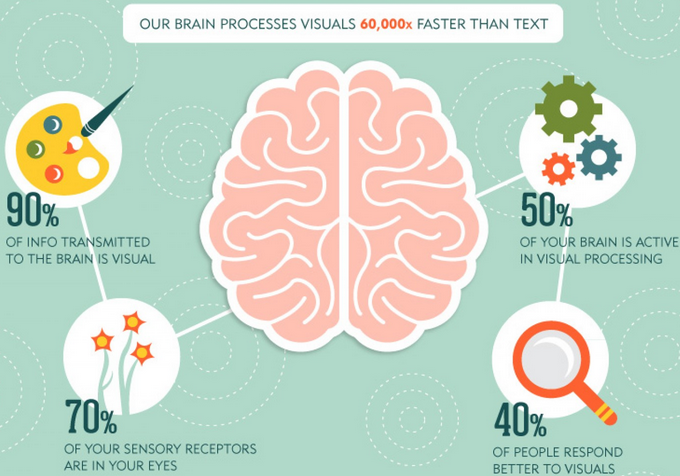Visual content marketing is more successful than any other form of communication. Marketers who embrace visual content reap the rewards of higher returns – in terms of more fans, followers, readers, leads, clients and, of course, revenue.
If you are not yet focusing on visual content in your marketing strategy, whether on social media or in your email campaigns, it’s time to re-imagine your plan. Visualize the benefits of incorporating stunning imagery and visuals to increase your reach, enhance your brand and earn more new business.
We are visual beings.
Visual content drives engagement. Neuromarketing science confirms it. Do you need some hard evidence to buy into the visual content marketing process before you’ll commit?
Review these fascinating statements based on case studies and experiments from psychologists, scientists, neurologists and other experts*:
- Graphics expedite and increase comprehension, recollection, and retention
- Visual clues help us decode text and attract attention to information or direct attention increasing the likelihood that the audience will remember
- Pictures enhance or affect emotions and attitudes
- Graphics engage our imagination and heighten our creative thinking by stimulating other areas of our brain (which in turn leads to a more profound and accurate understanding of the presented material)
- In a normal conversation, the importance of words is 7%, voice tonality is 38% and of body language is 55%
When you are ready to begin focusing on visual content marketing, remember to be consistent and innovative throughout your campaign.

Did you know?
- 90% of information transmitted to the brain is visual.
- The brain processes visual information 60,000 times faster than text.
- 40% of people respond better to an image than 1,000 words.
- 46% say a website’s design is the Number 1 criterion for discerning a company’s credibility.
- Posts with infographics grow traffic an average of 12% more than those without.
- 700 YouTube videos are shared on Twitter every minute.
- Pinterest generates more referral traffic than Google+, YouTube and LinkedIn COMBINED.
- Photos on Facebook garner more interaction than text, videos, and links.
- Visitors spend 100% more time on pages that have videos on them.
- Consumers who watch a product video are 85% more likely to purchase that product.
Do you need more accounting-related visual content?
Check out our Social Media Solutions!
*SOURCES:
M. Parkinson, “Do-it-Yourself Billion Dollar Graphics”. http://www.billiondollargraphics.com/infographics.html
H. van Oostendorp, J. Preece and A.G. Arnold (guest editorial), “Designing Multimedia for Human Needs and Capabilities,” Interacting with Computers Volume 12, Issue 1 (September 1999): 1-5.
J.R. Levin, A Transfer of Appropriate Processing Perspective of Pictures in Prose, (in H.Mandl and J.R. Levin [eds.]) Knowledge Acquisition from Text and Prose (Amsterdam: ElsevierScience Publishers, 1989).
W.H. Levie and R. Lentz, “Effects of Text Illustrations: A Review of Research,”Educational Communications and Technology Journal 30 (4) (1982): 195-232.
D. Bobrow and D. Norman, “Some Principles of Memory Schemata,” (in D. Bobrow and A.Collins [eds.]), Representation and Understanding: Studies in Cognitive Science (New York: Academic Press, 1975), 131-149 and D. Rumelhart, “Schemata: The Building Blocks of Cognition,” (in R.J. Spiro, B.C. Bruce and W.F. Brewer [eds.]), Theoretical Issues in Reading Comprehension (Hillsdale, New Jersey: Lawrence Erlbaum Associate, 1980), 33-58.







